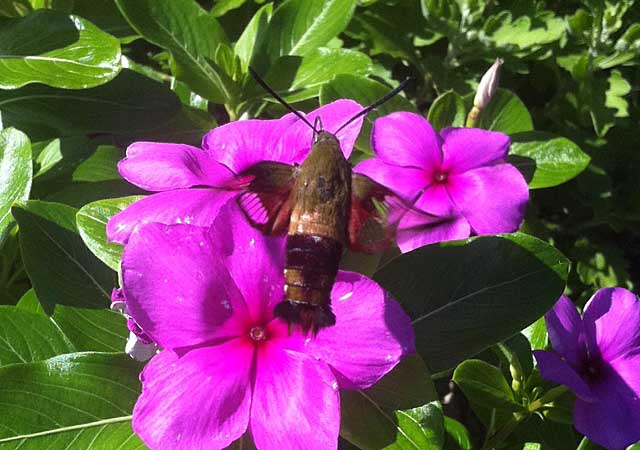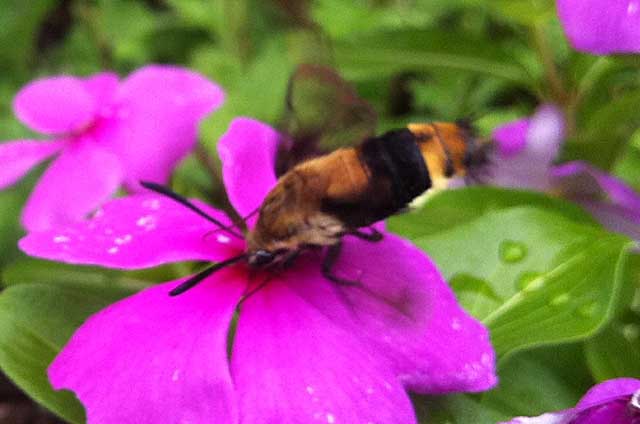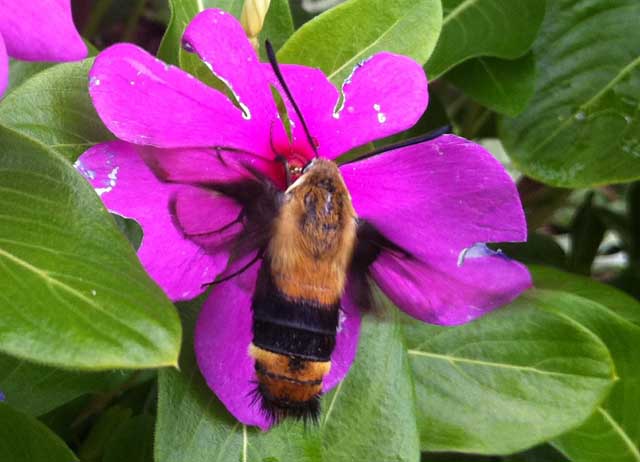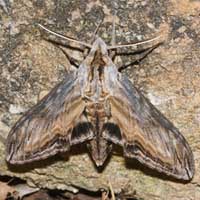|
|
Created/dedicated as per personal communication with Mark Russell, July 15, 2011
Updated as per James P. Tuttle's The Hawk Moths of North America, July 15, 2011
Updated as per BAMONA, formerly USGS, August 29, 2016
Updated as per personal communication with Nancy Wert (Eumorpha pandorus, Olney, August 27, 2016); August 29, 2016
|
Montgomery County, Maryland
Sphingidae

Hemaris thysbe nectaring, Montgomery County, Maryland,
July 15, 2011, courtesy of Mark Russell;
note burgundy abdominal bands and greenish body.
This page is inspired by and dedicated to
Mark Russell, who provides the Hemaris thysbe (above) and Hemaris diffinis (below) images on this page.
Mark writes, I have captured images of an Hemaris thysbe in the state of Maryland.
"I was just watering the plants in my garden and noticed this Hummingbird-like insect flying and hovering over flower pedals. Wasn't really sure what it was
until doing some extensive research into it. Came upon your website and thought it was AMAZING! So many different species, and classified into areas!
"These images are from Montgomery County Maryland, just north of Washington D.C. on July 15th, 2011."

Hemaris diffinis nectaring, Montgomery County, Maryland,
July 15, 2011, courtesy of Mark Russell;
note black legs, black abdominal bands and yellow-gold-body.

Hemaris diffinis nectaring, Montgomery County, Maryland,
July 15, 2011, courtesy of Mark Russell.
As of August 29, BAMONA lists the following Sphingidae from Maryland:
Agrius cingulata,
Amorpha juglandis,
Ceratomia undulosa,
Lapara coniferarum,
Manduca quinquemaculatus,
Manduca sexta,
Amphion floridensis,
Darapsa myron,
Eumorpha pandorus,
Hemaris diffinis,
Hemaris thysbe.
I have added many species which I (Bill Oehlke) feel are likely present. Please also send your sightings to BAMONA, an excellent online resource.
It is hoped that this checklist, with the thumbnails and notes, will help you
quickly identify the moths you are likely to encounter.
Please help me develop this list with improved, documented accuracy by sending sightings (species, date, location), preferably with an
electronic image, via email to Bill Oehlke.
Many thanks to Nancy Wert who provides the image of Eumotrpha pandorus below.

Eumorpha pandorus, Olney, Montgomery County, Maryland,
August 27, 2016, courtesy of Nancy Wert.
Visit Montgomery County, Maryland, Sphingidae Larvae: Caterpillars; Hornworms.
Visit Maryland Catocala: Underwing Moths.
Sphinginae subfamily
Sphingini tribe:
 |
This moth is a very strong flier, but would only make its way to
Baltimore County as a rare stray. There are very few records for Maryland.
|
 |
Ceratomia amyntor,
the Elm Sphinx or Four-horned Sphinx.
The upperside of the forewing is brown with dark brown and white
markings including a white costal area near the wing base, dark
streaks along the veins, and a white spot in the cell.
Larvae feed on Elm (Ulmus), birch (Betula), basswood (Tilia), and
cherry (Prunus). |
 |
The upperside of the forewing is yellowish brown with no white
markings, but there are indistinct black lines and dashes. The cell
spot is gray with a black outline. The larvae feed in large groups and are much more
spectacular than the moths. Catalpa is the larval host. |
 |
Ceratomia undulosa, the Waved
Sphinx.
The upperside of the forewing is pale brownish gray with wavy black
and white lines and a black-outlined white cell spot..
It is named for the wavy lines on the forewings. |
 |
The upperside of the forewing is dark brown with a dusting of white
scales. Some moths have patches of reddish or yellowish brown on the
wings.
|
 |
The upperside of the forewing is gray with heavy black bands. The
upperside of the hindwing is brownish gray with no markings.
|
 |
The upperside is of the forewing is gray with two (sometimes one or
three) black dashes near the wing center; other markings are usually
diffuse. The upperside of the hindwing is a uniform brown-gray. |
 |
Lintneria eremitus, the
Hermit Sphinx.
The upperside of the forewing is gray-brown with wavy lines, black
dashes, and one or two small white spots near the center of the costa.
.
Larval hosts are various species of beebalm (Monarda), mints (Mentha), bugleweed (Lycopis),
and sage (Salvia). |
 |
The upperside of forewing is gray to grayish brown with a black line
running from the middle of the costa to the middle of the outer
margin; the line may be broken near the margin. There is a splash of
brown around the cell spot.
|
 |
Manduca quinquemaculatus. Five-spotted Hawkmoth.
Abdomen usually has five but sometimes six pairs of yellow
bands. The upperside of the forewing is blurry brown and gray.
I suspect if you grow tomatoes, you are likely to encounter it.
|
 |
Manduca rustica, Rustic Sphinx.
The abdomen of the adult moth has three pairs of yellow spots. The
upperside of the forewing is yellowish brown to deep chocolate brown
with a dusting of white scales and zigzagged black and white lines.
unlikely possibility; stray
|
 |
Manduca sexta, Carolina Sphinx.
The abdomen usually has six pairs of yellow bands, broken across the
back. The sixth set of markings is quite small.
The upperside of the forewing has indistinct black, brown, and white
markings.
If you grow tomatoes, you have probably encountered it, though.
|
 | The upperside of the forewing is gray with indistinct black and
white markings. There is a series of black dashes
from the base to the tip, and a small white cell spot.Questionable
|
 |
Sphinx chersis,
Northern Ash Sphinx/Great Ash Sphinx. The upperside of the forewing is soft dark gray to blue-gray with a
series of black dashes, one of which reaches the wing tip.
|
 |
Forewings, long and slender, are held close to the body when the moth
is at rest.
|
 |
The outer margins of the forewings are slightly concave in the
male, but not in the female. The costal half of the forewings are
grey, but the posterior portion is a distinctive warm yellowish-brown.
|
 |
The upperside of the forewing ranges from brown with black borders
through brownish gray with paler borders to pale gray with no borders.
Dashes, submarginal line, and cell spot are usually weak.
|
 |
The lower forewings are predominantly brownish-yellow with a fairly
wide dark bar along the inner margin. At rest the wings hug the body,
giving the moth a long slender look.
|
Smerinthini Tribe:
 |
Amorpha juglandis,
Walnut Sphinx.
Adults are also highly variable; sometimes wings of an individual
may be all one color or may have several colors, ranging from pale to
dark brown, and may have a white or pink tinge. Patterns range from
faint to pronounced. See the file for the female; she is different.
|
 |
Pachysphinx modesta,
the Modest Sphinx or Poplar Sphinx
The larva is fond of poplars and willows.
This moth has a large, heavy body, and females can be remarkably plump. maybe
|
 |
Paonias astylus, Huckleberry Sphinx.
Both sexes rest with wings parallel to the resting surface, with the upper lobes of the hindwings protruding above the forewings. The
lower abdomen of the male arcs upward toward the head, while the abdomen of the female hangs strait down on a vertical surface.
|
 |
The outer margin of the forewing is quite wavy. There is a dark cell
spot and a dark oblique line mid wing from the costa almost to the
inner margin. Basic ground colour is pinkish brown.
|
 |
Named for the small eye-spot in the hindwing, this moth has a wide
distribution. Both sexes rest with wings parallel to the resting
surface, with the upper lobes of the hindwings protruding above the
forewings.
|
 |
Smerinthus jamaicensis closely resembles Smerinthus cerisyi, but jamaicensis is much smaller with larger blue patches on more
vibrant and deeper purple in the lower wings.
|
Macroglossinae subfamily
Dilophonotini tribe:
See Hemaris comparison to help distinguish
the next three species.
 |
It is not difficult to see why many gardeners would mistake an
Hemaris thysbe moth for a small hummingbird as it hovers,
sipping nectar from flowers through a long feeding tube.
|
 |
Hemaris diffinis, the
Snowberry Clearwing or Bumblebee Moth
Adults mimic bumblebees and are quite variable, both geographically
and seasonally. The wings are basically clear, with dark brown to
brownish-orange veins, bases and edges. The thorax is golden-brown to
dark greenish-brown.
|
 |
Hemaris gracilis, the
Slender Clearwing or Graceful Clearwing
Hemaris gracilis is distinguished from similar species by a pair of
red-brown bands on the undersides of the thorax, which varies from
green to yellow-green dorsally and sometimes brown with white
underneath. They have a red abdomen. unlikely
|
Philampelini tribe:
 |
It is fairly often reported
along the coast from southern New Jersey
to central Maine.
Note the differences between this moth and the Pandorus Sphinx.
|
 |
If you have Grape or Virginia Creeper nearby, then you probably have
this species. |
Eumorpha pandorus, Olney, August 27, 2016, courtesy of Nancy West.
Macroglossini tribe:
 |
This day flier is widely distributed. If you have Virginia Creeper,
you probably have the Nessus Sphinx.
Two bright, distinct, narrow yellow
bands are often visible on the abdomen.
|
 |
The lower wings of this hawkmoth are a solid brownish-orange,
matching the body colour.
You will often see this species listed as Darapsa pholus,
especially in older literature.
They are common
in Hunterdon County.
|
 |
Darapsa myron, Virginia Creeper Sphinx/Grapevine Sphinx.
The forewing upperside is dark brown to pale yellowish gray, with an
olive tint. On the costal margin there is a dark rectangular patch, although this
may be reduced or absent. The upperside of the hindwing is pale orange.
|
 |
If you have hydrangea growing near a stream, then you may have the
Hydrangea Sphinx.
The forewing upperside is often greenish brown
with curved dark lines and pinkish-white patches.
|
 |
The moth's outer margin of the forewing is deeply scalloped.
The upperside is light brown with dark brown markings.
There is a small black and white spot near the tip
|
 |
The forewing upperside is dark olive brown with paler brown along the
costa and outer margin, a narrow tan band running from the wing tip
to the base, and white streaks along the veins.
|
 |
This moth is very much under reported across the United States. It
is a rapid day flier so is probably not in too many collections.
Grape and Virginia Creeper are popular larval hosts.
|
 |
Xylophanes tersa,
Tersa Sphinx.
The upperside of the forewing is pale brown with lavender-gray at the
base and has dark brown lengthwise lines throughout. The upperside of
the hindwing is dark brown with a band of whitish, wedge-shaped marks.
|
|
|
Use your browser "Back" button to return to the previous page.
This page is brought to you by Bill Oehlke and the
WLSS. Pages are on space rented from Bizland. If you would like to become a "Patron of the Sphingidae Site", contact Bill.
Please send sightings/images to Bill. I will do my best to respond to requests for identification help.
Enjoy some of nature's wonderments: Saturniidae cocoons.
Cocoons of the giant silkmoths may be purchased in the fall and winter. Big and beautiful giant silk moths will emerge in spring/summer.
Read Actias luna rearing article. Additional online help available.
 | 
Show appreciation for this site by clicking on flashing butterfly to the left.
The link will take you to a page with links to many insect sites. |
You can access checklists for other states, and even for other countries in the Americas via
Sphingidae of the Americas.
This website has been created and is maintained by Bill Oehlke without government or institutional financial assistance. All expenses, ie., text reference
support material, webspace rental from Bizland, computer repairs/replacements, backups systems, software for image adjustments (Adobe Photoshop; L-View),
ftp software, anti-virus protection, scanner, etc. are my own.
I very much appreciate all the many images that have been sent to me, or of which I have been granted permission to copy and post from other websites.
All images on this site remain the property of respective photographers.
If you would like to contribute to the maintenace of this website by sending a contribution to
Bill Oehlke
Box 476
155 Peardon Road
Montague, Prince Edward Island, C0A1R0
Canada
your donation would be much appreciated and would be used for
1) paying for webspace rental;
2) paying for computer maintenance and software upgrades;
3) purchases of additional text reference material (journals and books) in anticipation of expanding the site to a worldwide Sphingidae site;
4) helping to pay my daughter's tuition (completed spring of 2013); with anything left over going to humanitarian aid.
If you are mailing a check from USA, please use $0.85 postage ($1.25 is 2015 rate). Donations can also be made through Paypal via the button below.





